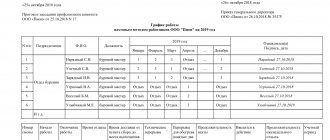Employment of disabled people in Russia
All rights of people who have disabilities are regulated by federal legislation, which also applies to the employment of people with health problems.
The following regulatory documents apply in this area:
- A constitution that guarantees the right to work to everyone without exception.
- Labor Code.
- Federal Law No. 181 of 2005, which concerns the social protection of people with disabilities.
- Order of the Chief Sanitary Doctor of Russia dated May 19, 2009.
The state protects citizens with disabilities, in particular, provides them with additional guarantees in the field of employment, helps them find jobs, and introduces special targeted programs.
Important
Every enterprise with more than 100 employees should have from 2% to 4% disabled people. This is a special state quota aimed at ensuring that all citizens with disabilities can get a job.
For enterprises where the number of employees is from 25 to 100 people, the number of disabled people should be 3%. At the same time, the calculation of the total number does not include employees who work in dangerous, harmful jobs - disabled people are still not accepted for such positions.
Before employment, a disabled employee must undergo a medical and sanitary examination, which should clarify the following points:
- Disability group, degree of disability.
- Working conditions in which a person can work based on health indicators.
In addition, MSEC monitors employers' compliance with their regulations and helps employees undergo rehabilitation programs.
Important
The MSEC conclusion is a necessary document for hiring an employee with a disability.
https://youtu.be/Y9ftdEACIb8
Features of the organization of work for disabled people
⇐ PreviousPage 4 of 7Next ⇒Employers, in accordance with the established quota for hiring disabled people, are obliged to: 1. Create or allocate jobs for the purpose of employing disabled people 2. Create working conditions for disabled people in accordance with the individual rehabilitation program for disabled people. 3 provide, in the prescribed manner, information necessary for organizing the employment of disabled people .
Compared to other workers, disabled people have advantages that are established by law: • reduced working hours for disabled people of groups I and II - no more than 35 hours per week with full pay (Article 92 of the Labor Code of the Russian Federation, Article 23 of the Law on Social Protection disabled persons);• annual leave of at least 30 calendar days (Article 23 of the Law on Social Protection of Disabled Persons);• duration of daily work (shift) - in accordance with a medical report (Article 94 of the Labor Code of the Russian Federation);• the right to use long-term leave without maintaining wages - up to 60 calendar days a year (Article 128 of the Labor Code of the Russian Federation). The legislator has also established more stringent restrictions regarding the involvement of disabled people: to overtime work (Article 99 of the Labor Code of the Russian Federation), to work on weekends and non-working holidays (Article 113 of the Labor Code of the Russian Federation) and to work at night (from 22:00 to 06:00). :00). The involvement of this category of workers in such work is allowed only with their consent and provided that such work is not prohibited for them due to health reasons (Article 96 of the Labor Code of the Russian Federation, Article 23 of the Law on Social Protection of Persons with Disabilities). In this case, the employer is obliged to inform the disabled person in writing of his right to refuse these types of work.
30 Methods of labor organization according to Taylor The first major step towards considering management as a management science was made by the American engineer F. Taylor (1856-1915), who led the scientific management movement. The problem of increasing labor productivity in an organization became an area of professional interest. The main works of F. Taylor: Factory Management (1903), Principles of Scientific Management (1911)
They formulated methods for the scientific organization of labor, based on the analysis of working time and work movements, standardization of techniques and tools. The effectiveness of joint work in an organization was considered from the standpoint of time and movement. The division of work into autonomous, fully programmable elements and their subsequent optimal integration into a single whole are mandatory conditions that, in accordance with the concept of the scientific management school, form a high-performance organization.
Taylor argued that management is a true science based on certain laws, rules and principles. Their correct use allows us to solve the problem of increasing labor productivity. If men are selected on a scientific basis, trained by progressive methods, stimulated by various incentives, and the work and the man are brought together, then a total productivity greater than the contribution made by the individual labor force can be obtained. His main merit is that he:
- developed the methodological basis for labor regulation;
- standardized work operations;
- introduced into practice scientific approaches to the selection and placement of personnel;
- developed methods for stimulating the work of workers;
- achieved recognition that work and responsibility are divided almost equally between workers and managers.
1. The authors of the theory of “scientific management” believed that using observations, measurements, logic and analysis, it is possible to improve many manual labor operations, achieving more efficient performance (analysis of the content of work and determination of its components).
2. Taking into account the human factor. An important contribution was the systematic use of incentives to motivate workers to increase productivity and production volumes. The possibility of necessary rest and inevitable interruptions in production was also provided for. This gave management the opportunity to set production standards and pay extra to those who exceeded the established minimum.
3. Scientific management also advocated the separation of the managerial functions of deliberation and planning from the physical execution of work. Taylor and his contemporaries recognized that management work was a specialty, and that an organization would benefit if each group of employees focused on what it did best. Previously, workers planned their own work.
Thanks to the concept of scientific management, management has become widely recognized as an independent field of scientific research. For the first time, managers, practitioners and scientists saw that the methods and approaches used in science and technology can be effectively used in the practice of realizing the goals of the enterprise.
31. The labor crisis is a state of aggravation of the manifestations of alienation of labor, consisting in the loss of its meaning-forming function (transformation from the basis of a way of life into a means of survival and devaluation of labor values) at the individual and social level of worker reproduction. In addition, the labor crisis is a transitional form in the development of ways to use the productive power of the hired worker. The “dying” of professions and occupations is one of the signs of a labor crisis, since workers who have knowledge and qualifications that are not in demand in the modern economy are immobile in the professional space and cannot immediately retrain and move on to another type of activity. The labor crisis is not a phenomenon of only domestic transformational relations, but, in our opinion, has deeper reasons that turn it into a cyclical phenomenon of economic practice, that is, the labor crisis, being resolved in a certain way, is regularly reproduced in various economic conditions due to the presence of hired labor. Factors and signs of a labor crisis can be divided into general, generated by the nature of hired activity, and specific, which include those operating only in transformational economic systems.
32. Alienation of labor is the transformation of human activity and its results into an independent force that dominates over himself and is hostile to him, and the associated transformation of a person from an active subject into an object of the social process. In reality, a person’s position in society is determined not only by labor, but also by socio-political conditions. Since participation in management was ensured by savings and other privileges, there was the possibility of receiving unearned, sometimes illegal, income in society. All this aggravated the alienation of labor and distorted the most important function of labor as a measure of distribution. The existence of alienation of labor is the basis of many contradictions. One of them is due to the fact that with the growth of education and the expansion of their general horizons, people’s desire for independence in work, for active participation in decision-making, and for revealing their own creative potential intensifies. But being alienated from the means of production, from the opportunity to influence the decisions made in management, the worker transferred his interests to other spheres of life. Alienation is a form of attitude towards work, characterized by feelings of meaninglessness, helplessness, and detachment.
33. “Human relations theory”, a concept of the principles and tasks of managing people in organizations (primarily industrial), developed in bourgeois social science. Originated in the 20s. 20th century in the USA as the ideological and methodological basis of industrial sociology of labor. Leading representatives of "Ch. O." t. in the USA - F. J. Roethlisberger, W. Moore, E. Mayo, in France - J. Friedman.” Ch. O." t. formed as an opposition to Taylorism. Having abandoned the biological and mechanical approaches of Taylorist “scientific management”, she put forward the task of introducing methods of treating the worker as a “social-psychological” being. In the basis of new methods of intensification and enhancement, t. proposed to take into account the psychological and moral qualities of a person (attitudes, motives, value orientations, etc.). The use of empirical research data on employee job satisfaction, the influence of collective demands and the psychological climate in the work cell on labor productivity stimulated attempts to develop a program for “harmonizing” the relations of various groups and individuals for the most effective functioning of the organization as a whole. This program took into account the requirements arising from modern technological progress. New technology, automation and mechanization of production processes have brought to the fore the task of educating a worker capable of constantly improving work skills. In addition, the ineffectiveness of sweatshop methods for increasing labor productivity was revealed. The practical needs of capitalist production prompted the study of important problems within the framework of “Ch. O." t.: factors that determine a positive or negative attitude towards work, the influence of the team on the individual, the effectiveness of forms and methods of leadership, improving working conditions, rest, free time, etc. In the title “Part. O." t. reflected the desire of bourgeois ideologists to pass off a program of practically valuable measures from the point of view of increasing profits as the “humanization of labor.” In fact, "Ch. O." t. seeks to obscure or “rationalize” the deep social contradictions of capitalist society.
34. The main types of participation of workers and their representatives in the management of the organization are the following. 1) Taking into account the opinion of the representative body of workers in cases provided for by the Labor Code, the collective agreement. 2) Conducting consultations with the employer by the representative bodies of workers on the adoption of local regulations. 3) Receiving information from the employer on issues directly affecting the interests of employees. 4) Discussion of issues of the organization’s work, making proposals for its improvement. 5) Discussion by the representative body of employees of plans for the socio-economic development of the organization. 6) Participation in the development and conclusion of collective agreements. 7) Other methods of participation of employees and their representatives in the management of the organization, determined by the Labor Code, other federal laws, constituent documents of the organization, collective agreement, local regulations.
35. Labor conflict is a type of social conflict, the object of which is labor relations and the conditions for their provision. A labor dispute is different from a labor dispute. Labor disputes include disputes between an employee (group of employees) and an employer regarding working conditions. Labor conflict is a broader concept. In addition to conflicts in the field of labor relations, it often includes a conflict of interests. For example, strikes or demonstrations may be accompanied by demands not only for higher wages, but also for improved food supplies and sometimes political demands. Therefore, a labor conflict can be regulated both by the norms of labor legislation and by other legal and non-legal means. Depending on which parties are involved in the struggle, one can distinguish interpersonal and intergroup labor conflicts, collective labor conflicts. Interpersonal conflicts are usually “vertical” conflicts "
36. Methods for resolving labor conflicts. A labor dispute is a disagreement between an employee (workers) and an employer regarding the establishment and application of current standards of labor and other social legislation, which were not resolved during direct negotiations with the employer and became the subject of proceedings in specially authorized bodies. An individual labor dispute is a dispute between the employer and a person who previously had an employment relationship with this employer, as well as a person who has expressed a desire to conclude an employment contract with the employer, if the employer refuses to enter into such an agreement. A labor dispute can be resolved through negotiations between the employee and the employer. The employee can negotiate either independently, and with the participation of a representative. Another body to which an employee can apply to protect his rights is the Prosecutor's Office of the Russian Federation or an appeal to the Federal Labor Inspectorate. He can also contact the Labor Dispute Commission - an extra-judicial body operating in the organization. The CCC is obliged to consider an individual labor dispute within 10 calendar days from the date the employee submits the application. The employee can go to court. The courts consider individual labor disputes based on applications from the employee, employer or trade union protecting the interests of the employee when they do not agree with the decision of the CCC. A collective labor dispute is an unresolved disagreement between workers and employers regarding the establishment and change of working conditions. The demands put forward are subject to mandatory approval at the appropriate meeting (conference) of workers. The meeting is convened by a representative body of workers and is considered valid if more than half of the workers are present. The demands of workers are sent to the employer in writing. Employers are required to consider the demands of employees sent to them within 3 working days from the date of receipt of the demands. There are three stages of conciliation procedures: conciliation commission, consideration of a collective labor dispute with the participation of a mediator, labor arbitration. When resolving collective labor disputes, a strike as a method of resolving a dispute can be used if Conciliation procedures did not help resolve disagreements between employees and employers
37. Prevention of labor conflicts Prevention of labor disputes at the employment stage: Firstly, it is necessary to conduct an interview with the future employee, during which the employer can find out how the level of professional training of the applicant meets the requirements. Secondly, it is worth talking with former colleagues and managers applicant, persons who can give recommendations about this employee. (at least a recommendation from a previous place of work in writing) Thirdly, you should request and study the personal documents of the applicant. The greatest interest for the employer, as a rule, is the work book, in which all necessary information is reflected about previous places of work, positions, working hours and reasons for the applicant’s dismissal. (except for the case of employment for the first time) Fourthly, before drawing up an employment contract, the employee must be familiarized with the local regulations of the organization (subject to signature). This is done so that the candidate knows in advance what kind of work awaits him. The main document regulating the relationship between the employee and the employer is the employment contract. All shortcomings of the employer in its development, execution and conclusion can be challenged by the employee (the contract must not violate the rights of one of the parties and is drawn up in accordance with the law). After concluding an employment contract with an employee and completing a probationary period, labor disputes may arise. In connection with With this in mind, it is necessary to carefully consider the policy for the prevention of various types of conflicts. It is important to remember that wages should be paid within the time frames stipulated by labor legislation. It is also necessary to comply with legal norms regarding the provision of annual paid leave. In addition, the employer should follow the procedure for providing those stipulated by labor legislation guarantees and compensations. For example, when an employee is sent on a business trip, he is guaranteed to retain his place of work (position) and average earnings
⇐ Previous4Next ⇒
Legal requirements
The employer is obliged to provide the disabled employee with comfortable working conditions. The premises must meet hygienic standards, and the disabled person must be completely safe. It is also necessary to take into account the conditions for the rehabilitation of employees with disabilities, prescribed by MSEC.
The following requirements apply to premises in which disabled people will work:
- Not the basement or basement floors.
- Enough free space, no obstacles for movement.
- Non-slip floor.
- A break room with an area of at least 12 square meters - at least 0.3 square meters for each employee with a disability.
- Regular wet cleaning.
Important
According to Article 92 of the Labor Code, disabled people of groups 1 and 2 must work no more than 35 hours a week. A person with a disability cannot be forced to work overtime, on weekends and holidays. You must obtain his written permission for this and take into account medical reports.
Quota for hiring disabled people
A quota is the mandatory number of places provided by law for people with disabilities in an enterprise. Organizations with fewer than 35 employees and public associations of disabled people are exempt from quotas.
In other cases, quotas are provided for disabled people:
- up to 3% in teams with 35–100 employees, the exact ratio can be adjusted at the regional level;
- 2-4% in teams with 100 or more workers, which is established at the federal level and is the same for all subjects.
Hardship vacancies are not taken into account as they are not considered for people with disabilities.
Contraindications to work for people with disabilities
It is forbidden to use disabled people in harmful, dangerous jobs; this is prohibited by medical indications. And the employer is responsible for the working conditions of such a special employee.
In particular, disabled people cannot be hired if the physical working conditions are as follows:
- There is a lot of noise.
- Draft.
- The room temperature is too high or too low.
- The room is not well lit.
- There are electromagnetic fields.
Chemical contraindications include high levels of gas and dust.
Biological contraindications - contact with viruses and the presence of infected microorganisms during activities.
Disabled people should not lift weights, run, or take uncomfortable body positions. In addition, contraindications include working on night shifts, monotonous work, and nervous breakdowns due to the unkind attitude of colleagues.
Labor protection for certain categories of disabled people
A person’s disability can be associated with diseases of a variety of organs, with damage to various ailments. For example, there are visually impaired people who should not work in loud noise, because for them hearing has become one of the main organs of perception of the surrounding reality and communication. At the same time, maximum lighting and the presence of glasses are very important for visually impaired people.
Disabled people with neuropsychiatric diagnoses are a completely different matter. They must first be examined at a neurological clinic in order to receive permission to work. Patients with tuberculosis should work in a separate room, in which there should be no threat specifically to the lungs or the entire respiratory system of employees.
People with hearing impairments should also not work in a room with strong background noise. And for heart patients, that is, people with heart and vascular diseases, the absence of vibrations is important, and the rooms need to be equipped so that loads and tilts are minimized.
Important
You need to pay attention to whether the disabled person’s workroom is located on the sunny or shaded side. For patients with tuberculosis, sun is beneficial and dampness is harmful, but employees with heart problems are better off working on the shaded side of the building.
Failure to meet employment quotas for persons with disabilities
Failure to comply with the law on quotas for persons with disabilities leads to administrative punishment of the employer and the organization headed by him, clause 42 of article 5 of the Code of Administrative Offenses of the Russian Federation. The amount of the penalty is 5–10 thousand rubles, depending on the degree of guilt and repetition of the violation.
The employer is obliged to notify the Employment Center about the availability of vacancies for people with disabilities and to consider submitted candidates for compliance with job requirements, Article 25 of Federal Law No. 1032-1. Applicants can independently search for job vacancies; if rejected, they will be given a written notification.
After hiring a person with a disability, the employer receives certain benefits from the state:
- social benefits (injury insurance for employees with disabilities) are reduced by 60%;
- subsidies for workplace equipment for special employees;
- to create the necessary conditions and a comfortable environment for such workers, the employer will receive compensation upon application to the project Employment Center.
The enterprise administration has the right to exceed the quota, and such steps contribute to obtaining additional government benefits. Failure to comply with the quota leads to punishment, and in case of repeated violations - up to the suspension of the enterprise.
Training and employment of disabled people is both a social responsibility of the enterprise owner and a legal requirement; failure to comply with it is subject to penalties.
Labor protection for disabled people of groups 2 and 3
Some employers believe that disabled people of group 3 should work on the same basis as all other employees. In fact, this is partly true. Disabled people of the third group can work in almost any field of production; they do not need medical reports or special recommendations. There are no difficulties for the employer in employing such disabled people, although labor protection must be at a fairly high level.
It’s already more difficult with disabled people of group 2. Employers are reluctant to hire such employees because they understand the level of responsibility and are afraid of frequent sick leave. It is important that the MSEC conclusion indicates what positions a disabled person of the second group can occupy and what work he can perform due to health reasons. And if the employer fulfills all these requirements, then there will be no special problems with employment.
Important
The MSEC structure can send a disabled person to work in a specific organization.
Employment Laws for Persons with Disabilities
Having a disability does not mean that a person drops out of society and is left alone with problems. If a citizen with this status wants to work, the state helps him, and at the legal level. The social and labor rights of people with disabilities cannot be violated, so both parties must familiarize themselves with the current provisions and strictly adhere to them.
Among the many laws on the employment of people with disabilities, we highlight the main ones:
- Federal Law No. 181 as amended 07/29/2018, regulating the social protection of people with disabilities, and in matters of employment, Articles 20, 21 on quotas;
- Federal Law No. 1032-01 as amended. 12/11/2018, on employment of the population, disabled people, Article 24.1;
- Article 3 of the Labor Code, which indicates the limitation of the scope of activity for medical reasons;
- Article 5.42 of the Labor Code establishes cases of violations in the field of employment and employment;
- Article 57 of the Labor Code reflects the requirements for an agreement concluded with a disabled person, which must reflect certain conditions;
- Article 128 of the Labor Code on the specifics of providing leave (regular and unpaid).
In addition to these legal norms, the laws stipulate all situations arising in labor relations in which an employee with a disability is a party.
Guarantees of the Labor Code for disabled people
The Labor Code of Russia guarantees the following rights to disabled employees:
- No overtime.
- Ability to not work on holidays and weekends, regardless of management requirements.
- Article 115 states that the annual paid leave of disabled people is at least 30 calendar days.
- Disabled people of groups 1 and 2 work no more than 35 hours a week. For disabled people of group 3 there is no such restriction.
- You can apply for free leave for 60 calendar days per year.
- The employer is obliged to apply all the benefits established by law for disabled employees.
Job quotas
Quotas for jobs for disabled people are regulated by Art. 20 No. 181 of the Federal Law “On Social Protection of Disabled Persons in the Russian Federation”. According to the law, the employer is required to hire a certain number of people with disabilities. The larger the organization, the more jobs should be provided to people with disabilities.
So, if a company has from 35 to 100 employees, the quota is 3% of the average number. If the company employs more than 100 people, the quota is from 2 to 4%. It should be noted that until 2013, only large enterprises had to enter into employment contracts with disabled people - the government believed that quotas for medium-sized businesses would complicate the activities of organizations.
According to the law, companies must submit the following reports to the employment service every month:
- whether the quota of jobs for people with disabilities has been met;
- local regulations with information on whether the appropriate workplaces are equipped;
- data on allocated or created jobs.
In some regions (for example, in the Tula, Belgorod, Amur regions), local authorities approach quota requirements differently. It is possible to rent special workplaces - most often contracts are concluded with specialized enterprises or with public organizations, associations of people with disabilities. It turns out that disabled people work in an organization that meets sanitary standards, and receive wages from the tenant company.
Dismissal due to disability
If a change in health status occurs during the term of the employment contract, this may be a reason for dismissal. The basis may be a certificate of disability and an individual rehabilitation program. An IPR is usually a recommendation, and a person has the right to refuse to participate in the program. For work, he can only provide a certificate of disability, which helps to obtain the benefits provided for by the code.
It is worth noting that when staffing is reduced, disabled people have preferential rights to retain their jobs if:
- qualifications and labor productivity are not inferior to other employees;
- the injury that caused the disability was received at this workplace;
- the disabled person is a WWII veteran or a combat veteran.
An employment contract with a disabled person can be terminated if the employee is unable to work and this fact is confirmed by a medical report. So, according to clause 5, part 1, art. 83 of the Labor Code of the Russian Federation, if a person can no longer perform work according to his position, the employer has no reason to continue cooperation with him.
As a rule, restriction of work activity of the first degree allows work in the same conditions, but it is necessary to reduce the volume and severity of work. A second degree restriction allows you to perform work in specially created working conditions, and with a third degree restriction, a person is considered disabled. Dismissal of a group 3 disabled person, as a rule, is rarely permitted - restrictions on an individual rehabilitation program are usually insignificant.
If necessary, the terms of the employment contract can be changed - it is possible to transfer the employee to another position that will correspond to the individual rehabilitation program. This requires the consent of the employee and an official transfer agreement; it is impossible to simply dismiss a group 2 disabled person.
If the organization does not have suitable conditions for continuing work or the employee refuses the transfer, dismissal will be carried out in accordance with clause 8 of part 1 of art. 77 Labor Code of the Russian Federation. A person must be warned about dismissal in advance; before the expiration of the employment contract, he can be removed from work. No salary will be accrued during this time.
An order to terminate the employment contract will be issued on the basis of a medical report.
To summarize, dismissal of a disabled person is possible in the following cases:
- in the absence of vacancies suitable for the disability group, vacancies with easier working conditions;
- at your own request;
- if your health condition does not allow you to continue to perform your job duties;
- upon refusal to transfer to another position.










